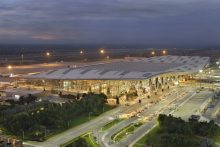 BLR Cargo recorded a total throughput of 439,524 metric tonnes in FY ’24, reflecting a notable 7.1% increase from the preceding financial year. International tonnage reached 266,186 metric tonnes, exhibiting a 4% growth over the previous year, while domestic tonnage experienced a strong 13% rise, totaling 173,338 metric tonnes in comparison to the previous year.
BLR Cargo recorded a total throughput of 439,524 metric tonnes in FY ’24, reflecting a notable 7.1% increase from the preceding financial year. International tonnage reached 266,186 metric tonnes, exhibiting a 4% growth over the previous year, while domestic tonnage experienced a strong 13% rise, totaling 173,338 metric tonnes in comparison to the previous year.
In FY ‘24, BLR Cargo continued its growth momentum operating to 33 destinations, as compared to 25 destinations in FY 23. Serving as a vital gateway, BLR Cargo facilitated exports to top international destinations with significant growth in export commodities such as agri perishables, machinery parts, and pharmaceutical products. The top five destinations for exports include LEJ (Leipzig/Halle), CGN (Cologne Bonn), ORD (Chicago O’Hare), DXB (Dubai), and SIN (Singapore Changi).
Another freighter, Oman Air Cargo started operations from December 2023.
In May 2023, BLR Airport achieved a significant milestone with the successful completion of India’s most notable brownfield cargo transition. As part of this transition, the cargo terminals are now mainly managed by Menzies Aviation (Bengaluru) Private Limited (MABPL), and WFS (Bengaluru) Pvt Ltd (WFSBPL). Additionally, a new Domestic Cargo Terminal project initiated by MABPL is under progress and will be operational within the next year.
Furthermore, Air India SATS Airport Services (AISATS) has undertaken the development, financing, operation, and maintenance of a new greenfield logistics park for a period of 15 years. The 370,000 sq. ft park will feature Grade-A warehouse space with facilities like cold storage and custom bonded warehouses. These collaborative efforts between BLR Airport and its partners are aimed at boosting operational efficiency, expanding cargo handling capacity, and supporting the growth of cargo operations. BLR Airport remains committed to expanding its cargo handling capabilities, aiming to achieve a cargo handling capacity of around 1 million metric tonnes per annum by the end of the decade.
 Cargo Breaking News
Cargo Breaking News

